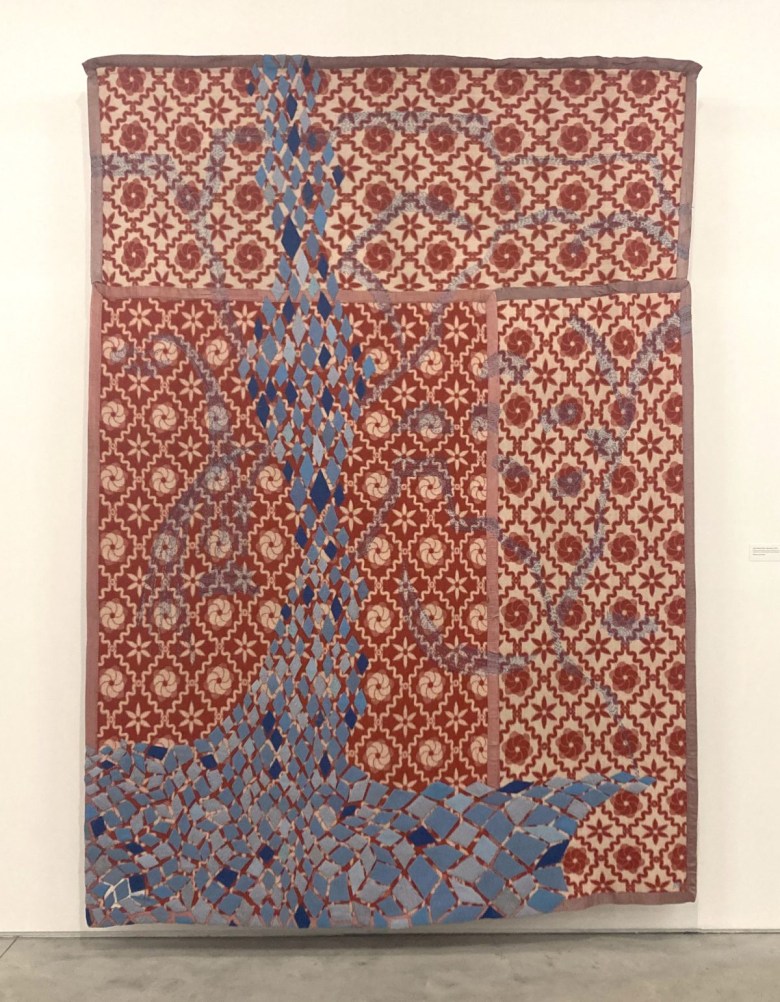Marie Watt’s current exhibition at Print Center New York requires slowness. Storywork is the first show to focus on Watt’s printmaking practice, though she has been engaged with the medium for over 30 years, with the show’s earliest works dating from 1996. Today, the artist is best known for her textile pieces, for which she cuts up blankets she’s “reclaimed” from secondhand stores and pieces them together into massive, sensual wall hangings.
The relationship between Watt’s textile and printing work is immediately obvious in woodcuts and lithographs like “Mend” (2009) and “Landmark: A Thousand Names” (2013) that imitate details from a quilt and works in which felted and stitched fabrics have been pressed into the print surface to create texture. The softground etching series Companion Species (Malleable/Brittle) (2021), a linguistic portrait of the twin beings Sapling and Flint from an Iroquois creation story, is displayed alongside her preparatory blanket and embroidery collages and one of the copper plates used to create the work. It’s a neat curatorial touch to show her process, one that helps viewers read the layers of texture in the finished plate and really see its depth.
Three of Watt’s blankets hang on display here, along with three large sculptures. “Blanket Stories: Great Grandmother, Pandemic, Daybreak” (2021) is composed of blankets donated to Watt in response to an open call, stacked to a height of eight feet; each neatly folded blanket has a swing tag bearing the name of its donor and a brief history. It’s clear that, for Watt, collage is both an artistic process and a political tool: a way to bring together material and stories, a cultural bricolage.
There’s also a tidiness to her work. The same delicacy and precision is visible in both her prints and textiles. These are works that ask you to be intimate with them, to come close and feel the making. “East Meets West Summit” (2014) is particularly gorgeous, with its sashiko-like stitching. Her blankets have the additional impact of scale, and though two works from Companion Species, “Passage” and “Rock Creek, Ancestor, What’s Going On?” (both 2021), are almost as large, I found them less compelling. This is partly because of how text-heavy they are — the abstract shapes of the blanket pieces are more engaging than the layered words. Her prints, though beautiful, can be a little too understated, and feel at times like studies for the textiles. “Threshold” (2006) completely dwarfs the adjacent lithographs, but the Companion Species works, which refer to Iroquois and European stories of identity and ancestry, are enhanced by being shown in relation to each other.
My favorite work, though, was neither print nor blanket, but rather the charming “Companion Species (Ancient One)” (2017), a tiny she-wolf in cast bronze, reclining on a piece of wool cut from a blanket belonging to Watt’s grandmother. It’s tucked away by the bathrooms and coat rack, easy to miss, and it encapsulates the threads of Storywork perfectly: At the core, all of Watt’s work shows a devotion to care and closeness, a desire to make tangible the layers of relations that bind and make us.






Storywork: The Prints of Marie Watt, from the Collections of Jordan D. Schnitzer and His Family Foundation continues at Print Center New York (535 West 24th Street, Chelsea, Manhattan) through May 18. The exhibition was curated at the University of San Diego by John Murphy; the Print Center presentation was organized by Jenn Bratovich and Robin Siddall.

